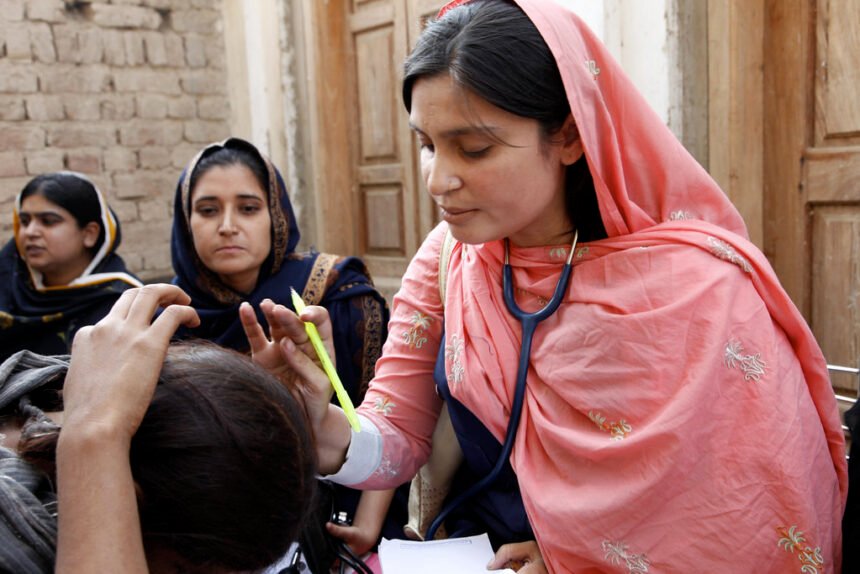Imagine sitting in a cramped, dimly lit room in rural Punjab, the weight of the world on your shoulders. That’s where Nagina finds herself, her eyes tracing the cracks in the mud walls of her home. Her husband, a laborer scraping by on daily wages, just spent two weeks in a private hospital battling pneumonia. The bill? A staggering 150,000 Pakistani Rupees—half a year’s worth of their income. To settle it, they sold their only buffalo, the lifeline that gave them milk and a sliver of financial stability. Now, Nagina wonders how they’ll feed their kids or keep the roof over their heads. Her story isn’t a one-off. It’s a gut-punch reminder of how Pakistan’s healthcare system, with its pay-as-you-go setup, is pushing families like hers to the brink.
In Pakistan, healthcare is a game of Russian roulette for the poor. You pay out of your pocket for every test, every pill, every night in a hospital bed. Data from the National Health Accounts (2015–16) shows that 64.4% of health spending comes straight from people’s wallets, with 89% of private healthcare costs borne by households. This fee-for-service model—where every service has a price tag—hits low-income families like a sledgehammer. Unlike systems where insurance or taxes cover the bulk of costs, this setup leaves patients exposed, like a house with no roof in a monsoon. And it’s not just the bills. It’s the way they pile up, forcing folks to choose between getting better or going broke.
The numbers tell a grim story. A study in ScienceDirect dug into the Household Integrated Economic Survey and found that in 2015–16, 4.51% of households faced what experts call “catastrophic health expenditures”—costs that eat up more than 10% of their budget. By 2018–19, that number had skyrocketed to 13.15%. For families scraping by on a few thousand rupees a month, one hospital stay can tip them over the edge. Take Nagina’s case: selling that buffalo didn’t just wipe out their savings; it stole their future. Across the country, people are selling land, jewelry, or whatever they’ve got to cover medical bills, only to end up deeper in the hole.
What makes this mess even uglier is the way some hospitals play dirty. Private facilities, which handle most of Pakistan’s healthcare, often act like wolves in sheep’s clothing. A 2019 Dawn investigation uncovered horror stories of patients charged for tests they never got or slapped with inflated bills for basic care. Ever heard of a hospital billing 10,000 rupees for a bandage? It happens. With little government oversight, these places can jack up prices or push unnecessary procedures, knowing families like Nagina’s have no choice but to pay up. It’s like being mugged when you’re already down.
For low-income families, the stakes are life-or-death. Human Rights Watch reported in 2021 that 57% of healthcare costs in Pakistan come from out-of-pocket payments. For someone earning $2 a day, a single doctor’s visit can feel like a financial death sentence. The HIES data paints an even bleaker picture: 5% of households slid from scraping by to extreme poverty after medical expenses in 2018–19. Meet Muhammad Boota, a domestic worker in Lahore. He shells out a third of his salary for insulin, leaning on patchy charity to get by. One missed dose, and he’s staring down a hospital stay he can’t afford. It’s a tightrope walk with no safety net.
The system’s bias toward private care only widens the gap between haves and have-nots. Public hospitals, meant to be a lifeline for the poor, are underfunded, overstretched, and often a last resort. Pakistan spends just 1.5% of its GDP on healthcare—one of the lowest in South Asia. In rural areas, where 60% of folks live, you’re lucky to find a doctor, let alone a specialist. Need cancer treatment? Good luck—most facilities are in big cities like Karachi or Lahore. A study in Health Research Policy and Systems points out that travel costs, lost wages, and lodging add insult to injury, making healthcare a luxury for rural families. It’s like asking someone to climb Everest in flip-flops.
The government’s Sehat Sahulat Program, which offers insurance for hospital stays to the poorest, is a step in the right direction. But it’s like putting a Band-Aid on a broken leg. It covers only certain inpatient treatments, leaving out outpatient care and chronic conditions like diabetes or hypertension. Medicines, which eat up nearly two-thirds of health spending, are often bought out-of-pocket, even in public hospitals where stocks run dry. BMC Health Services Research found that households using private care are far more likely to face catastrophic costs than those sticking to public facilities. But when public hospitals are crumbling, what choice do people have?
This pay-as-you-go model isn’t just bad for wallets—it’s bad for health. Doctors and hospitals get paid for every service, so there’s no incentive to focus on prevention or long-term care. It’s like a mechanic who only gets paid to fix your car after it breaks down, not to keep it running smoothly. Private clinics push pricey tests and procedures, while public hospitals, strapped for resources, leave patients undertreated. The World Health Organization says strong health systems need financing that shields people from crushing costs. Look at Thailand: they slashed catastrophic expenditures with universal coverage, blending taxes and insurance to keep costs low. Pakistan? We’re still stuck in the dark ages.
The human toll is what keeps you up at night. In Khyber Pakhtunkhwa, a farmer named Iqbal sold his tiny plot of land to pay for his daughter’s appendectomy. Then came the kicker: extra charges for follow-up care. Now his family rents a shoebox-sized room in town, their roots in the village cut off. Stories like his are everywhere. The International Journal for Equity in Health says big families, those with chronic illnesses, or those far from clinics are hit hardest. Women, often putting their kids’ needs first, face extra hurdles—cultural norms and empty pockets keep them from getting care. It’s a house of cards, and one illness can bring it all crashing down.
So, how do we fix this mess? For starters, Pakistan needs to pump more money into public healthcare—aim for 4% of GDP, like the WHO suggests. That could beef up public hospitals and ease the pressure on private ones. Next, expand Sehat Sahulat to cover outpatient care and chronic diseases, and make sure people know how to sign up. Regulating private hospitals is non-negotiable—set price caps, enforce transparency, and audit bills to stop the fleecing. Finally, bet big on prevention: more clinics, more vaccinations, more education to catch problems early. Countries like Cuba, spending 12.6% of GDP on health, or Bolivia, with prepaid systems, show it’s possible to do more with less.
Nagina and Iqbal aren’t just statistics—they’re people caught in a broken system. Pakistan’s fee-for-service model is like a runaway train, barreling over the poor and vulnerable. We can’t keep letting families lose everything to stay alive. It’s time to rethink healthcare, to build a system that lifts people up instead of kicking them when they’re down. Universal coverage, fair financing, and a focus on prevention could turn the tide. The question is: will we act before more families like Nagina’s lose their buffalo, their land, their hope?






